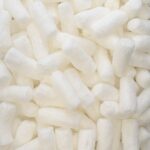When it comes to shipping delicate items, ensuring they arrive safely and intact is of utmost importance. However, the materials used for packaging have often been a cause for concern due to their environmental impact. In this article, we will delve into the fascinating world of packing peanuts and uncover the surprising ingredients behind them.
Prepare to be amazed as we explore the hidden secrets behind these tiny yet mighty protectors. We will reveal how innovative advancements have led to the development of environmentally friendly alternatives that not only safeguard your packages but also contribute positively towards our planet’s well-being.
The Unseen Heroes: Foam Peanuts
When it comes to protecting fragile items during shipping, foam peanuts quietly take on the role of unsung heroes. These tiny, lightweight pieces of expanded polystyrene (EPS) offer exceptional cushioning and shock absorption properties that ensure your package arrives intact. But what exactly makes foam peanuts such reliable protectors?
The magic lies in their structure. Foam peanuts are created through a process called extrusion, where polystyrene beads are expanded into a foam by injecting them with steam. This results in a network of interconnected cells that give the peanuts their distinctive shape. These air-filled cells allow foam peanuts to compress under pressure, effectively absorbing shocks and preventing damage to delicate contents.
In addition to their excellent cushioning abilities, foam peanuts are also incredibly lightweight. Their low density not only reduces shipping costs but also minimizes environmental impact by requiring fewer resources for production and transportation. This means that while these little heroes tirelessly protect your goods, they do so with an eco-friendly touch.
Uncovering the Secret: Biodegradable Packing Peanuts
Packing peanuts, those small but essential pieces of foam that protect our packages during shipping, have long been a topic of concern when it comes to their impact on the environment. However, there is an innovative solution that is gradually gaining popularity – biodegradable packing peanuts. These remarkable alternatives are made from materials that break down naturally over time, leaving behind minimal waste and reducing our carbon footprint.
One of the most commonly used biodegradable materials in packing peanuts is cornstarch. Derived from renewable sources, cornstarch packing peanuts are designed to dissolve quickly and harmlessly when exposed to water or moisture. This means that instead of lingering in landfills for hundreds of years like their traditional counterparts, they simply disappear, leaving no trace behind.
But how do these biodegradable packing peanuts manage to maintain the same level of protection as their non-biodegradable counterparts? Manufacturers have ingeniously discovered that by interlocking the foam particles during production, they can achieve a structure that offers durability and cushioning without compromising on environmental friendliness. This breakthrough allows for peace of mind when it comes to protecting fragile items during transit while also contributing to a more sustainable future.
Sustainable Packaging Solutions: Thinking Outside the Box
When it comes to sustainable packaging solutions, it’s essential to think outside the box. While traditional packing peanuts made from expanded polystyrene have been widely used, they are not environmentally friendly. However, in recent years, innovative alternatives have emerged that prioritize sustainability without compromising functionality.
One such alternative is the use of biodegradable packing peanuts. These ingenious packing materials are typically made from plant-based materials like cornstarch or potato starch. They offer the same protective qualities as their traditional counterparts while being compostable and easily breaking down in natural environments. This not only reduces waste but also eliminates the need for energy-intensive recycling processes.
Another sustainable option gaining popularity is the use of recyclable packing peanuts. These innovative materials are often created using post-consumer recycled content or biodegradable polymers that can be recycled alongside other plastics. By diverting waste from landfills and promoting a circular economy, these recyclable peanuts play a vital role in reducing our carbon footprint and fostering a more sustainable future.
From Nature to Your Doorstep: Corn Starch Peanuts
Corn starch peanuts, also known as biodegradable packing peanuts, are an innovative and eco-friendly solution that has gained significant traction in recent years. Derived from the humble corn plant, these packing peanuts offer a sustainable alternative to traditional foam-based options. The use of corn starch in packaging materials exemplifies how nature’s resources can be harnessed to create functional products that minimize environmental impact.
One of the most remarkable features of corn starch peanuts is their biodegradability. Unlike their petroleum-based counterparts, these peanuts break down naturally over time, leaving no harmful residues behind. When exposed to moisture or microorganisms in soil or water, they undergo a process called hydrolysis, transforming into harmless substances like carbon dioxide and water. This means that even if these peanuts end up in landfills or bodies of water, they will not contribute to long-term pollution.
Furthermore, the production of corn starch peanuts relies on renewable resources. Corn is an abundant crop worldwide and can be cultivated sustainably without depleting natural ecosystems. By using corn as a raw material for packaging, we are effectively reducing our dependence on fossil fuels and mitigating the negative environmental impacts associated with traditional plastic manufacturing processes. Embracing corn starch-based packaging offers a compelling vision of a future where our everyday items are derived from renewable sources.
The Versatile Champion: Expanded Polystyrene
When it comes to packaging materials, one name stands out for its unmatched versatility and reliability: expanded polystyrene. This remarkable material, commonly known as EPS, has become the unsung hero of the shipping industry. With its exceptional properties and countless applications, expanded polystyrene is a testament to human ingenuity and innovation.
At its core, expanded polystyrene is a lightweight cellular plastic derived from fossil fuels. The manufacturing process involves expanding tiny beads of polystyrene with steam, transforming them into a resilient foam that combines strength with flexibility. This simple yet ingenious creation method allows for an array of uses in different industries ranging from construction to food packaging.
One of the key advantages of expanded polystyrene is its insulating power. Due to its closed-cell structure, it effectively traps air within the foam matrix, making it an excellent thermal insulator. This property has made EPS an indispensable material in temperature-sensitive applications such as coolers and insulated shipping containers. Not only does it help keep perishable goods fresh for longer periods during transit, but it also aids in reducing energy consumption by maintaining stable internal temperatures.
Recycling Made Easy: Recyclable Packing Peanuts
In today’s world, where environmental concerns are at the forefront of our minds, the quest for sustainable packaging solutions has become more crucial than ever. One remarkable innovation in this realm is the advent of recyclable packing peanuts. These ingenious little foam pieces not only provide excellent cushioning for delicate items during transit but also possess the remarkable ability to be recycled.
Recyclable packing peanuts are typically made from expanded polystyrene (EPS), a lightweight and durable material commonly used in packaging. The beauty of these peanuts lies in their recyclability, as they can be easily collected, sorted, and processed into new products. Once used to protect your valuable goods, these packing peanuts can embark on a new journey when placed in the recycling bin.
When it comes to recycling these versatile foam pieces, many municipalities now accept them as part of their curbside recycling programs. Moreover, some shipping companies and packaging supply stores even offer drop-off points specifically designated for the collection of used packing peanuts. By diverting these materials from landfills through proper recycling channels, we not only reduce waste but also conserve valuable resources.
Going Green with Starch-Based Packing Peanuts
Amidst growing environmental concerns, the search for sustainable packaging materials has gained momentum. One such eco-friendly alternative is starch-based packing peanuts, which offer a remarkable solution to reduce our carbon footprint without compromising on the protection of our valuable shipments.
Derived from plant starches, such as corn or potatoes, these packing peanuts are revolutionizing the packaging industry. Their inherent biodegradability ensures that they break down naturally over time without leaving harmful residues in our ecosystems. This means that even if they end up in landfills or water bodies, they will not persist and pollute for generations.
What sets starch-based packing peanuts apart is their ability to dissolve in water. This feature not only makes them incredibly convenient for disposal but also eliminates any concerns about wildlife consuming them accidentally. In fact, some environmentally conscious individuals have gone a step further by repurposing these biodegradable peanuts as compost material, enriching the soil and contributing to a more sustainable future.
Compostable Packing Materials: A Natural Alternative
As the world becomes increasingly conscious of the environmental impact of packaging materials, a new breed of packing peanuts has emerged – compostable packing materials. These innovative alternatives provide an eco-friendly solution that not only protects your fragile items during transportation but also leaves a positive impact on our planet.
Compostable packing peanuts are typically made from renewable resources like cornstarch or wheat starch. When these peanuts break down, they can be added to compost piles or organic waste systems, where they decompose naturally without releasing harmful toxins into the environment. This means that not only are you able to dispose of your packaging waste responsibly, but you also contribute to the creation of nutrient-rich soil for future plant growth.
Beyond their compostability, these natural packing materials possess other remarkable qualities as well. They are lightweight yet sturdy enough to cushion fragile items effectively. Additionally, they have anti-static properties which prevent them from clinging to objects while still providing excellent shock absorption. This makes them an ideal choice for companies and individuals looking to minimize their carbon footprint without compromising on protection and functionality.
Beyond Styrofoam: Cornstarch Packing Peanuts
Amidst the growing concerns about the environmental impact of traditional packing materials, a remarkable alternative has emerged – cornstarch packing peanuts. These innovative little warriors are gaining popularity due to their ability to provide excellent cushioning and protection while being eco-friendly at the same time.
Derived from natural ingredients, cornstarch packing peanuts are made from a renewable resource that offers several advantages over their Styrofoam counterparts. One of the most significant benefits is their biodegradability. Unlike traditional foam peanuts that linger in landfills for centuries, these corn-based alternatives break down easily and decompose into harmless substances.
What’s truly fascinating about cornstarch packing peanuts is that they can actually be dissolved in water! Yes, you read that correctly. They possess the magical ability to vanish with just a splash of water, leaving no trace behind. This unique feature makes them an ideal choice for environmentally conscious individuals who want to reduce waste and minimize their carbon footprint.
Sustainable Packaging Materials: Paving the Way for a Greener Future
As the world becomes increasingly aware of the environmental impact of our choices, the demand for sustainable packaging materials is on the rise. Thankfully, there are innovative solutions emerging that offer a greener alternative to traditional packing peanuts.
The Rise of Mushroom Packaging
One exciting development in sustainable packaging is the use of mycelium-based materials derived from mushrooms. These fungi possess incredible properties that make them ideal for eco-friendly packaging. By harnessing mycelium’s growth capabilities, it can be grown into custom shapes and sizes, creating a versatile and biodegradable alternative to foam peanuts. What’s more, mushroom packaging decomposes naturally within weeks, leaving behind nutrient-rich compost that enriches soil.
Additionally, mushroom-based packaging requires fewer resources to produce compared to conventional plastics and foam peanuts. It can be cultivated using agricultural waste such as corn stalks or sawdust—materials that would otherwise go unused or discarded. By utilizing these organic byproducts, mushroom packaging not only reduces waste but also helps decrease reliance on fossil fuels.
The Promise of Seaweed Packaging
Another promising sustainable alternative making waves in the packaging industry is seaweed-based materials. Seaweed possesses impressive properties that make it suitable for transforming into biodegradable and compostable packing solutions. With its abundance in oceans worldwide, seaweed offers an abundant and renewable resource.
Seaweed packaging has a minimal carbon footprint throughout its production process as it requires no land cultivation or excessive water usage typically associated with other crops like corn or soybeans. Furthermore, after being used as packaging material, seaweed can naturally break down within a matter of months without releasing harmful toxins into the environment.
Fruit Waste Packaging: An Unexpected Solution
Ever wondered what happens to fruit waste after it’s processed? Well, one innovative approach being explored is using fruit waste fibers to create sustainable packaging materials. By repurposing discarded fruit peels and fibers, these materials can be transformed into biodegradable and compostable packing peanuts, reducing the need for traditional foam-based alternatives.
This ingenious solution not only diverts organic waste from landfills but also offers a renewable resource that can be continuously utilized. Imagine a future where the peels of oranges, pineapple tops, or apple cores are transformed into protective packaging that safely transports your valuable items while helping our planet thrive.
In conclusion, sustainable packaging materials are paving the way for a greener future. From mushroom-based alternatives to seaweed and fruit waste packaging solutions, these innovative materials not only reduce waste but also contribute to soil health when composted. By embracing these eco-friendly options, we can make a positive impact on our environment and create a better world for future generations.
Eco-Friendly Packing Materials: Making a Difference One Box at a Time
As the world becomes more environmentally conscious, the demand for eco-friendly packing materials has increased significantly. The use of sustainable options not only reduces waste but also helps to combat the negative impact of traditional packaging on our planet. In this section, we will explore some of the innovative ways in which businesses are adopting greener solutions, making a positive difference one box at a time.
Biodegradable Packing Peanuts: A Natural Alternative
Traditional packing peanuts made from expanded polystyrene (EPS) have long been criticized for their detrimental effects on the environment. However, thanks to technological advancements and growing awareness, biodegradable packing peanuts have emerged as an excellent alternative. These innovative materials are typically made from plant-based sources like corn starch or wheat. Unlike their non-biodegradable counterparts, these peanuts dissolve easily in water and can be safely composted or disposed of without causing harm to ecosystems.
By choosing biodegradable packing peanuts, businesses are not only reducing their carbon footprint but also actively contributing to a healthier planet. These eco-friendly options provide the same protective cushioning as traditional packing materials while allowing for guilt-free disposal methods. With more and more companies embracing this sustainable approach, we can collectively make a significant impact on reducing packaging waste globally.
Paper Packaging: A Versatile Solution
Paper packaging has been around for centuries and is now gaining traction as an eco-friendly alternative to traditional plastic packaging materials. Made from renewable resources such as recycled paper fibers or sustainably sourced wood pulp, paper offers versatility and resilience without compromising its environmental impact.
This biodegradable option finds extensive application in industries ranging from e-commerce to food services. From corrugated cardboard boxes to paper filling products like crinkle-cut shred, businesses are finding creative ways to use paper packaging solutions that not only protect their products but also align with their commitment towards sustainability. By opting for paper packaging, companies demonstrate their dedication to reducing waste and preserving our planet’s resources.
Plant-Based Alternatives: A Greener Choice
Another promising development in the realm of eco-friendly packing materials is the emergence of plant-based alternatives. Materials such as mushroom packaging, made from mycelium (the root structure of mushrooms), offer a sustainable and biodegradable solution to traditional foam packing materials.
Mushroom packaging not only provides excellent cushioning but is also fully compostable, breaking down naturally without leaving harmful residues behind. Similarly, other plant-based alternatives like seaweed-based packaging or pineapple fiber composites are seeing increased attention for their ability to provide effective protection while being gentle on the planet.
By embracing these plant-based alternatives, businesses can embrace a greener ethos and inspire others to follow suit. Choosing eco-friendly packing materials not only benefits the environment but also enhances brand reputation and fosters a sense of responsibility among consumers. Together, we can make a difference by making conscious choices that prioritize sustainability without compromising product integrity.
Conclusion
In conclusion, the humble packing peanut has undergone a remarkable transformation. From its initial use as a protective filler, it has evolved into an eco-friendly solution that aligns with our growing concerns for the environment. Whether it’s the ingenious corn starch or recyclable options, these surprising ingredients have revolutionized the way we pack and ship goods. By embracing sustainable packaging materials, we are taking proactive steps towards reducing our carbon footprint and creating a greener future for generations to come. So next time you receive a package filled with packing peanuts, remember the hidden ingredients and feel good about making an environmentally responsible choice.






